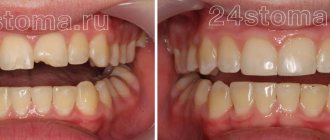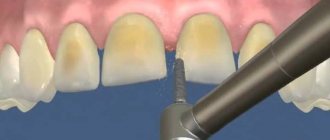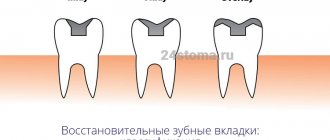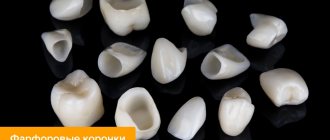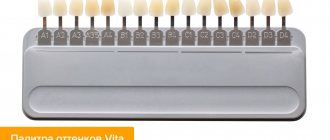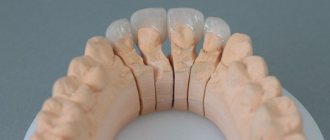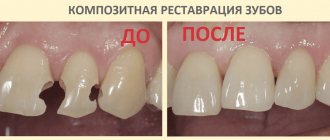Why polishing is needed
Hygienic teeth cleaning is always accompanied by grinding. During this procedure, tiny irregularities in the enamel may form. In this case, polishing the teeth helps a lot, creating a uniform smoothness of the entire surface. Main indications for grinding and polishing:
- cleansing of bacteria when planning surgical procedures;
- during orthodontic treatment of uneven bite, as well as when installing and removing braces;
- for polishing fillings and forming a smooth transition from material to tissue;
- when leveling the surface of teeth after their restoration; after removing stone from enamel;
- when selecting the color of tooth crowns or filling material.
Almost any manipulation of dental tissue must be performed in conjunction with polishing. This procedure works well not only from a hygienic point of view, but also in terms of creating an aesthetically bright smile with a natural shine.
Recommendations after the teeth polishing procedure
To maximize the effect of the procedure, it is important to follow the dentist’s recommendations and follow simple rules:
- for the first 2-3 days, avoid eating foods containing dyes: tea, coffee, wine, juices, etc.,
- food should not be too hot or cold, because the sensitivity of the enamel increases in the first days after polishing,
- When brushing your teeth, you should not use whitening pastes, as they can damage the enamel,
- In the first days after polishing, you should stop smoking, because the acids contained in tobacco smoke corrode the protective layer of enamel, and this accelerates the formation of plaque.
If you follow the recommendations and take good care of your teeth, professional cleaning will not be needed soon, and your teeth will remain healthy.
Polishing tools
The entire polishing process is carried out using several replaceable attachments on a drill. An abrasive paste is applied to the working surface, after which the enamel is exposed at high speeds.
The following attachments are available:
- in the form of a rubber bowl - for flat surfaces;
- a cone-shaped brush - for treating natural tubercles on distant teeth;
- strips - for hard-to-reach areas, including the interdental area.
Special pastes contain silica, silicate, zircon, xylitol and fluorine. They are distinguished by abrasiveness:
- high degree - eliminates dense stains;
- medium degree - polishing of small deposits;
- low degree - polishing of color irregularities;
- very low level - maximum softness to complete polishing.
How is the procedure performed?
Teeth polishing serves as the final step for both mechanical and ultrasonic cleaning. Also, a laser procedure is gaining increasing popularity, with which you can grind the enamel as accurately and painlessly as possible.
The entire process of caring for the surface of teeth includes several steps:
- Preparation. To prevent it from being difficult for the patient to keep his mouth open all the time, special mouth openers or retractors are used. All tools and attachments are also prepared in advance. If necessary, the oral cavity is cleaned with a stream of water, and then from the center towards the lateral teeth, dental floss is passed through the interdental space.
- Grinding. There is a consistent destruction of plaque, stone and other formations using nozzles and abrasives. Particular attention is paid to hard-to-reach places, subgingival pockets and 4, 5, 6, 7, 8 lower and upper teeth, since they bear the maximum chewing load. Next, the flat surfaces are ground, and then all teeth are disinfected.
- Polishing teeth after cleaning steps. Using a paste with a fine fraction, roughness is eliminated. The abrasive mixture is distributed using a special brush.
- Applying mineral paste or gel.
After polishing, the enamel absorbs fluoride well, so this stage restores the tissue and gets rid of new deposits for several months.
Hygienic tooth polishing is an important component of oral care, without which it is impossible to fully clean and maintain the enamel.
Polishing effect
After professional hygiene, the oral cavity is considered completely cleansed and will have high resistance to various pathogenic influences for some time. The final polishing stage has the following effects:
- noticeable teeth whitening;
- uniform enamel color due to the removal of all stubborn dirt;
- smooth, pleasant surface of the teeth;
- visible shine of enamel;
- further prevention of inflammation and plaque deposits;
- improving the quality of restoration;
- correction of tooth shape after filling;
- getting rid of unpleasant odor;
- restoration of the natural properties of enamel.
As a result of polishing, teeth gain the ability to cope with negative influences and food loads, as well as avoid oral infections.
Nuances of preparation and restoration of cervical defects
L. A. Lobovkina , Candidate of Medical Sciences, doctor of the highest category, head of the medical and preventive department of Branch No. 6 of the Federal State Institution “GVKG im. Burdenko" of the Ministry of Defense of the Russian Federation L.V. Raynauli Ph.D., head of the medical (dental) department of Branch No. 6 of the Federal State Institution "GVKG im. Burdenko" of the Ministry of Defense of the Russian Federation P. L. Lobovkin , dentist-therapist, doctor of the highest category, Branch No. 6 of the Federal State Institution "GVKG im. Burdenko" of the Ministry of Defense of the Russian Federation
The cause of the formation of a defect in the cervical area can be diseases of carious and non-carious origin. The diagnosis influences the amount of preparation, the shape of the cavity and the choice of filling material. In addition, it is important to identify whether the process has spread under the gum and whether there is a need to correct the mucous membrane of the gingival margin.
Preparation of a carious cavity is, on the one hand, a medical manipulation that determines the effectiveness of treatment of pathology of hard dental tissues; on the other hand, it is a technological process that ensures aesthetics, strength and reliable fixation of the restoration, preservation of the biomechanical and strength parameters of the remaining hard dental tissues, as well as optimal conditions for the interaction of filling materials with enamel and dentin [1]. To fill defects that are noticeable when smiling, you should choose a material with good aesthetic characteristics, that is, composites, compomers or ormokers. Unfortunately, with the development of “artistic dental restoration”, all “related” manipulations, including preparation, have become just a by-product this “restoration and artistic service”. Such underestimation by practitioners of the importance of correctly carrying out the stage of preparation of hard dental tissues often leads to technological and medical errors, irrational and ineffective use of burs, deterioration of long-term treatment results, the development of complications, and unreasonable financial costs. Our analysis showed that errors in preparation may be associated with such phenomena as postoperative sensitivity, inflammation and death of the dental pulp, “white line”, violation of the marginal fit of the composite restoration with staining of its border with enamel and dentin, the development of recurrent caries, etc. d. [1, 2]. From a “technological” point of view, class V cavities present a certain problem for the dentist. This is primarily due to the fact that these cavities are located very close to the gingival margin, and sometimes extend under it. Therefore, the preparation of class V cavities requires the following conditions to be met (Lutskaya I.K., 2010): thorough necrectomy of enamel and dentin; excision of enamel that has lost contact with dentin; bevel the enamel over its entire thickness towards the equator; the bottom of the cavity can be formed convex; the angle between the gingival wall and the bottom can be sharp to avoid injury to the gingival margin; all internal corners are smoothed.
When choosing a material for filling class V cavities, it is necessary to take into account: • the activity of the carious process; • access to the lesion; • possibility of insulation from moisture; • patient's age; • aesthetic requirements of the patient. To fill defects that are noticeable when smiling, you should choose a material with good aesthetic characteristics, that is, composites, compomers or ormokers. If the cavity is localized within the coronal part and neck of the tooth, only white aesthetics correction is required. When carrying out this type of restoration, it is optimal to use mainly dentin shades. This is due to the fact that the neck is the most opaque part of the tooth, and the layer of natural enamel in the cervical area is very thin and becomes thinner over the course of life, almost disappearing. In addition, the gingival zone is illuminated both by light falling on the surface of the tooth and by light reflected and passed through the gum. The use of enamel shades results in the restoration being gray in color (Dubova M.A., Shpak T.A., 2004). Polymerization of the material is carried out through the tooth and from the side of the tooth neck to ensure high-quality attachment of the material. Very often errors occur in the sequence of introducing filling material into class V cavities. So, usually the first layer is applied to the gingival wall, and the next - to the wall facing the chewing surface or cutting edge. But the adhesion of the composite to enamel is much stronger than to dentin. Therefore, with this method of applying the material, it is detached from the gingival wall and a marginal gap is formed. Subsequently, it is in this place that the development of “recurrent” caries begins. Therefore, it is most optimal to apply the material first to the wall facing the enamel of the cutting edge (in this area the enamel is thicker and the bevel is larger), and then to the gingival wall. Subsequent layers are added to the bottom of the cavity. Polymerization of the material is carried out through the tooth and from the side of the tooth neck to ensure high-quality attachment of the material.
Rice. 1. Teeth 2.3, 2.4 and 2.5: initial clinical situation.
Clinical case Patient B., 63 years old, came for oral sanitation. After conducting basic and additional research methods, a diagnosis was made: teeth 2.3, 2.4, 2.5 - dentin caries (Fig. 1). Infiltration anesthesia Ubistesini Forte 1.5 ml and cleaning of the tooth surface with Clint paste (VOCO) were carried out. Please note that when preparing class V cavities, it is necessary to carry out prophylactic expansion of the cavity to the mesiodistal curves of the crown. Otherwise, at the filling-tooth border, a carious process very quickly reappears, since this area is a retention point for dental plaque.
Rice. 2. Tooth 2.3: insulation with LCDam.
When restoring cervical defects, especially those accompanied by recession of periodontal tissues, isolation using a rubber dam is inappropriate, since a clasp applied to the tooth can provoke even greater progression of recession. Retraction cord is not the treatment of choice in this case, as it can also aggravate gum recession. The most optimal means of isolating cervical defects is a liquid rubber dam, for example LCDam (VOCO, Germany), which is blue in color and contrasts well with the oral mucosa. In addition, LCDam adheres well to the mucosa and does not move when subjected to mechanical action (Fig. 2). When restoring cervical defects, especially those accompanied by recession of periodontal tissues, isolation using a rubber dam is impractical. Next, adhesive preparation of the cavity is carried out. We used the 6th generation self-etching adhesive system Futurabond HP (VOCO, Germany). Long-term clinical trial data has demonstrated Futurabond HP's extremely high bond strength levels, which are comparable to those obtained using the total etch technique. It saves time, which is especially valuable in gerontological and pediatric practice. In addition, Futurabond HP releases fluorides, which prevent the development of “secondary” caries. Many dentists use self-etching adhesive systems in their practice to fabricate temporary direct restorations. However, when restoring defects of non-carious origin, the use of such adhesive systems is most effective. This is due to the fact that over time, hypermineralization (dentin sclerosis) occurs in the area of the bottom of the defect, leading to the closure of the lumen of the dentinal tubules with mineral crystals, making it difficult for adhesive systems to access these areas. Self-etching adhesive systems do not remove the smear layer, but transform it, simultaneously decalcifying the surface layer in the defect area in combination with preliminary etching of the bevel boundaries with phosphoric acid. Thus, the adhesion of the adhesive to the hard tissues of the tooth is high.
Rice. 3. Teeth 2.3, 2.4 and 2.5 after the Polofil Supra restoration.
After adhesive preparation of the cavity, the first layer of Grandio Flow (VOCO) high-flow composite is applied to the wall facing the incisal edge. "Grandio flow" is a fluid universal nanohybrid filling material. It has optimal physical characteristics, and in some respects (surface strength and abrasion resistance) it is superior not only to certain flowable, but also pasty hybrid composites. After adhesive preparation of the cavity, the first layer of the high-flow composite “Grandio flow” (VOCO) was applied to the wall facing the incisal edge. The second layer of the composite “Grandio flow” was applied to the gingival wall. Next, for the restoration, the material “Polofil Supra” was used - a microhybrid composite with a syntraglass microfiller system, thanks to which it has excellent aesthetic characteristics. The material is easily polished and retains its shine for a long time. In addition, its cost is significantly lower than the cost of analogues - an important factor when choosing a material in the context of the global economic crisis. The final appearance of the restoration is shown in Fig. 3. Thus, the presence in the doctor’s arsenal of materials of various consistencies makes it possible to produce an inexpensive direct restoration and at the same time optimally solve the problem of the marginal fit of the composite material in the gingival area and, therefore, prevent the development of complications (recurrent caries, chipping of part of the tooth crown, etc.). d.).
How often should sanding and polishing be done?
After brushing, the surface of the teeth remains smooth for a long time, but there are inevitable processes during which the enamel can gradually become covered with a layer of plaque again. The frequency of grinding together with polishing should be determined by the attending physician.
Typically, for oral cavity that does not require treatment and other dental procedures, dental treatment is carried out once a year. For coffee or cigarette lovers, it is possible to shorten the period or carry out selective grinding of teeth.
The best prevention of caries is achieved by polishing, carried out once every six months. In this case, it is an excellent addition to daily care.
Methods of conducting
The cost of comprehensive teeth cleaning at the dentist is determined by the set of procedures offered, which, as a rule, includes not only ultrasonic treatment of enamel, but also grinding, as well as protective treatment of enamel. The most popular methods are classical and air grinding.
The classic approach using a drill involves the use of abrasive pastes that make it possible to qualitatively level out roughness and correct the shape of the tooth. This is an effective and simple technique from a technical point of view, however, it must be taken into account that the procedure can cause discomfort - high temperature, specific sound and intense vibration cause inconvenience to both patients and dentists.
An alternative option is air sanding. The progressive technique reduces the likelihood of tissue and enamel damage, takes less time and does not require large volumes of painkillers.
Contraindications
The condition of the enamel and teeth directly affects the indications for polishing. However, the ability to grind all teeth may be limited for a number of reasons:
- acute viral diseases;
- serious cardiovascular diseases;
- early and late stages of pregnancy;
- inflammation of tissues in the mouth;
- extensive caries;
- severe bleeding gums;
- periodontitis and progression of tooth mobility;
- thinning and fragility of enamel;
- problems with kidneys and salt metabolism;
- individual or allergic reaction to the composition of pastes and other drugs.
In any case of contraindications, exceptions are possible. The safety of the procedure is determined by the dentist or other supervising physician. It is usually recommended to first eliminate the cause or wait for a favorable course of the disease.
Polishing cost
The average price for teeth polishing in Moscow is determined by several factors:
- total cost of hygienic cleaning;
- required number of teeth for polishing - one tooth, upper or lower dentition or the entire oral cavity;
- type and method of grinding;
- manufacturer of tooth polishing pastes.
Moscow offers many different options for this service with a wide range of prices. Each dentistry has its own characteristics and equipment used.
At the Elite-Dent clinic you can polish your teeth at a competitive price. We constantly have special offers, promotions and discounts for our clients. The teeth polishing service is included in professional hygiene, which also includes the removal of tartar and plaque using the AirFlow technique. In addition, we offer a free consultation to all patients, during which an experienced doctor will examine, give recommendations and answer all questions.
Process technique
In dentistry, grinding refers to the leveling of enamel through mechanical action . You should not try to perform a similar procedure at home, because... Without professional skills, it is easy to damage the enamel.
This manipulation is part of a single complex for treating the surface of the teeth: it follows immediately after professional cleaning , thanks to which the oral cavity gets rid of contaminants.
At the same time, the procedure precedes the polishing stage , with which it is closely related.
Professional cleaning and grinding of the teeth place local stress on the enamel. Polishing, on the contrary, thanks to the application of special compounds, acts as a protective manipulation for the surface.
Advantages of polishing in Elite-Denta
Our clinic’s specialists polish teeth after treatment procedures, as well as as part of hygienic cleaning. We offer our patients the best conditions:
- experienced highly qualified doctors;
- affordable price and availability of benefits;
- advantageous offers and discounts;
- online registration for services;
- proximity to the center of Moscow and metro stations;
- work on high-tech equipment;
- use of modern materials;
- speed of the procedure;
- complete painlessness of grinding and polishing;
- no tissue injury during hygienic cleaning;
- if necessary, use local anesthesia.
We will provide high-quality polishing for your teeth, as a result of which you will get an attractive, radiant smile.
Reviews
Patients who have successfully completed the procedure note that the result debunks the myth about subsequent tooth decay. Moreover, they often write that teeth begin to look whiter and more beautiful.
Sometimes they complain of increased sensitivity, as a result of which they cannot live a normal life, for example, drink hot coffee in the morning. But a small percentage of negative reviews, most of which were the result of the dentist’s unprofessionalism, suggests that in general this procedure is useful and safe.
You can share your opinion in the comments to this article.
If you find an error, please select a piece of text and press Ctrl+Enter.
Tags: tooth enamel professional teeth cleaning ultrasonic teeth cleaning teeth cleaning
Did you like the article? stay tuned
Previous article
Biohorizon implants: features of installation and engraftment
Next article
What determines the service life of dental implants?
